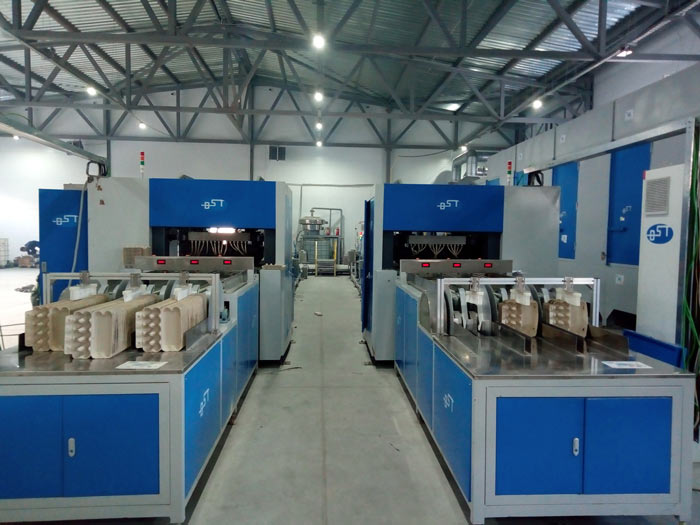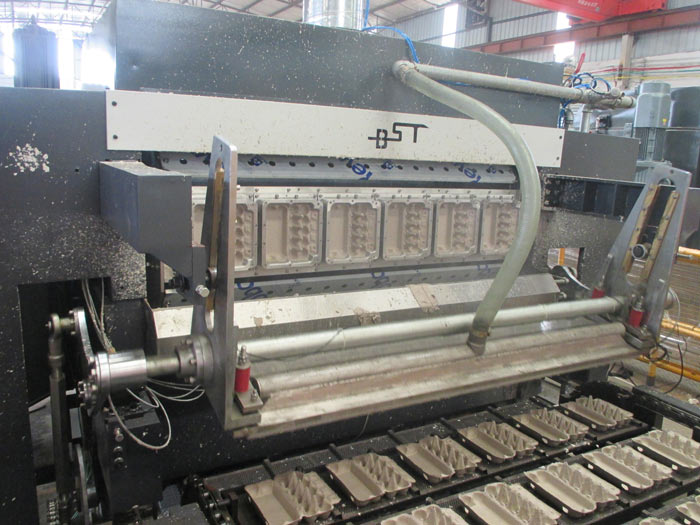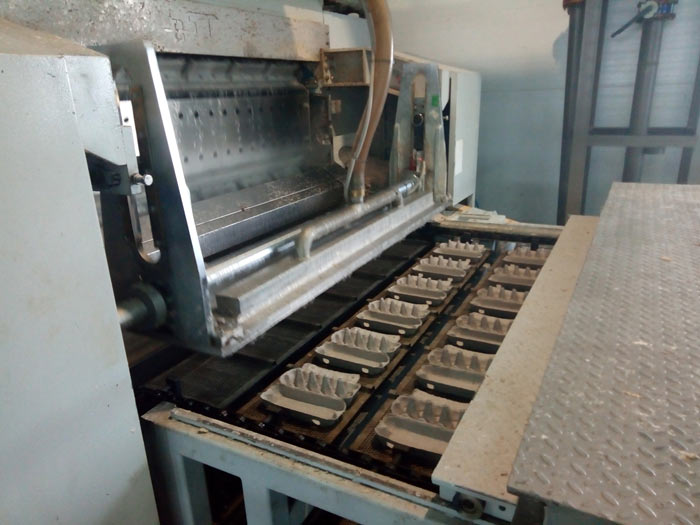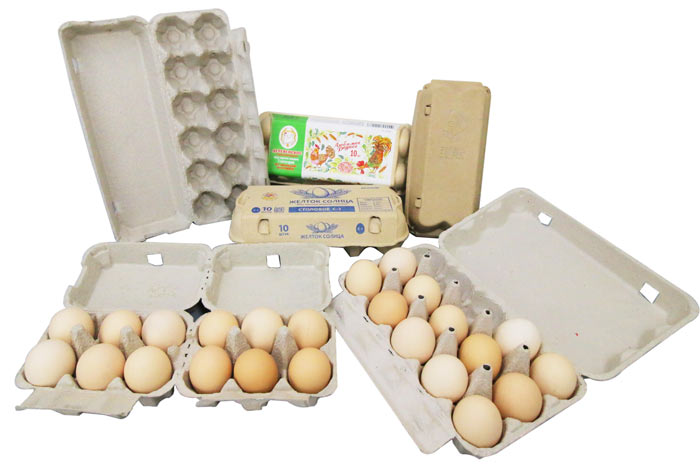Paper Pulp Moulding Process Explained
- Categories:Industrial Information
- Author:bst
- Origin:
- Time of issue:2022-10-12
- Views:0
(Summary description)Paper Pulp Molding Process - How It Works
Paper Pulp Moulding Process Explained
(Summary description)Paper Pulp Molding Process - How It Works
- Categories:Industrial Information
- Author:bst
- Origin:
- Time of issue:2022-10-12
- Views:0
paper pulp moulding process
After the pulp has been washed, it is then mixed with chemicals and heated to make sure the fibers are evenly distributed throughout the mixture. Once the mixture is ready, it is poured into molds where it will set and dry.
Pulp molding process product is a three-dimensional paper-based product that uses recycled pulp such as waste paper as the main raw material, adopts a unique pulp molding process and related additives in the papermaking industry, and is pressed on a special mesh mold to form a three-dimensional paper-based product. Pulp molding process products are also called paper molds or paper trays (hereinafter referred to as pulp molds).
The pulp molded products produced by the pulp molding process are mainly used in the transportation buffer protection of eggs and small electronics, and can also be made into beverage cup holders, medical utensils, disposable flower pots, etc.
The following briefly introduces the production process and design basis of pulp molding process products.
The production process of pulp molding products can be as follows: raw material (waste paper) screening, shredded paper beating, preparation of slurry (concentration), pulp sizing, product molding, product drying, product shaping, post-processing, etc., but to sum up It is mainly divided into five processes: pulping, molding, drying, shaping, and post-processing.

(1) Pulping process
This is the first process of pulp molding process products, mainly relying on or learning from the papermaking process. First of all, the raw materials of waste paper or other raw materials should be sorted and screened. Due to the wide range of sources of waste paper, there are waste newspapers, leftovers from corrugated cardboard packaging, and leftovers after cardboard printing, etc.; so they should be carefully classified before beating. And remove all kinds of impurities. The machines generally used are hydraulic grinders and sorters. The second is shredded paper beating, which needs to be ground and pulped and converted into uniform paper. The third is to prepare the slurry. Because the specific gravity, hardness and color of the raw waste paper are different, the slurry should be prepared according to the requirements of the products to be produced to meet the product requirements required by customers. The fourth is pulp sizing. Pulp sizing is used to improve the liquid penetration resistance and waterproof performance of the product. Generally speaking, the glue applied to the paper mold is rosin, paraffin wax latex or rosin paraffin glue. Blending rosin gum is the key to sizing. Since the paper mold is an injection molding product, different from the production of cardboard, the sizing concentration of the pulp during production should be high, about 1%-2%.
(2) Forming process
Usually, the forming of pulp molding process products is to fill the volume of the model and the upper part of the casing with pulp, the water will be discharged through the metal mesh wall of the model, and the fibers will be attached to the surface of the mesh model; through a certain period of fiber deposition, When a certain thickness is reached, the molding ends. After forming, lift the model with the help of hydraulic cylinder, and close the upper and lower models to compact the product and take it out. The main function of this compaction process is to squeeze out part of the water in the product; The moisture content after extrusion is about 50%-75%.
For the pulp molding process, if the number of products produced is not large, a single product is usually formed and the material is manually connected; for some large batches of paper molds, such as egg trays, coffee cup trays, shoe supports and other products, continuous rotary equipment will be used. To complete the molding process, the automation efficiency can be greatly improved.
(3) Drying process
Usually, the drying of pulp molding process products is carried out in a drying furnace of periodic or continuous operation, mainly to reduce the moisture content in the products to 10%-12%. In a drying oven or continuous drying conveyor, hot air is mainly used to dry the product, the temperature at the beginning is 250℃-300℃ (the moisture content of the product is reduced by 50% in 7-10 seconds), and then the temperature is reduced to 100℃- 105°C. There is a conveying device in a continuous drying furnace, and the parts pass through different temperature zones in the furnace, and finally dry to a moisture content of about 10%-12%.
(4)Integer process
Usually, the shaping of pulp molding process products is hot extrusion on a thermoforming machine, so that the products are more dense, the thickness of the wall is uniform, the outer surface is smooth and flat, and the strength of the wall is improved, which are very necessary for the product. Sometimes it is necessary to press some signs on the paper mold, which can be carried out in this process, without the need to make it when the molding mold is made, and then make it during the molding process, so that the produced signs are prone to appear unclear, It is easier to avoid such problems when it is carried out in the shaping process.
For some wet pressing paper molds, the two processes of drying and heat shaping are combined, and the formed products are directly passed through the wet heat shaping equipment to directly complete the products. In this way, the surface texture of the product is smooth and flat, and the hardness of the product is better than that of the traditional paper mold. The paper mold printing effect produced by this wet pressing process is also very good, and it is suitable for the packaging of some consumer goods or high-end products. high-end product packaging.
(5) Subsequent processing
Pulp molding products can be used after drying, but sometimes special follow-up treatments are required, such as calendering, paint baking or printing pattern text on the surface.
All paper molds have a demoulding slope, and similar products can be stacked together. For some mass-produced paper molds, there is generally an automated stacking process. The stacked products sometimes use a press. Pressed to reduce uncompactness during stacking, so that the overall size of the product when shipped will be smaller, increasing the number of shipments loaded.
The paper mold is a product with a relatively complex shape and a large size, and at the same time, it has the basic characteristics of bearing capacity, buffer capacity, and positioning function. Based on these special and basic requirements, the technological characteristics of this type of paper mold are determined: no matter how complex the shape of the product is, the wall thickness of the same product must be the same, only in this way can the product be shaped and shaped (or dried) in the production process.

Mold making of pulp molds
In the whole production process of pulp molding process products, an indispensable tool is the mold, and the molds used in different processes of the paper mold are also different, and the following three sets of molds may be required: suction molding, heat Compression molding die, positioning trimming die. The latter two molds depend on the requirements of the product, but the suction molding mold is an indispensable mold in the production process. Generally, for the production of industrial paper molds, the following three molds may be used: suction molding molds, hot-pressing molding molds, and trimming molds. The selection of the mold becomes the key to the production process. The latter two molds are only needed when shaping and trimming are required; however, the suction molding mold is an indispensable one in the production process of paper molds. The following describes the situation of these types of molds.
Slurry forming mold:
Mainly, the pulp is formed into a wet paper mold, which is generally divided into two parts, an upper mold and a lower mold. The upper mold for forming includes three parts: upper template, positioning frame and epoxy resin part. The upper template and the positioning frame are connected with screws or rivets; the epoxy resin part is solidified after the reaction of epoxy resin and its curing agent; the epoxy resin part and the positioning frame are directly bonded together by epoxy resin .
1- Core
2- upper template
3- Positioning Box
4- Press the border
5- skirt frame
6- Bottom plate
7- Lower Template
8- Epoxy
9-Paper mold
The forming lower mold includes: lower template, bottom plate, skirt frame, pressing frame, and core. They are connected by screws or rivets. Except for the epoxy resin part, the materials of the upper and lower molds can generally be cast iron or cast aluminum, or wood can be used directly.
The core and skirt frame are the main forming parts of the paper mold, and their shape is determined by the shape of the formed paper mold. The back of the core and skirt frame should be hollowed out, leaving a wall thickness of 5~8mm. There should be at least one 2.5mm through hole on the wall of the molding part of the core and the skirt frame every 12~15mm, as the channel for air and water under the action of positive and negative pressure. The surface of the forming part is covered with a layer of net, the function of this layer of net is to let the water pass through and let the pulp fibers adhere to it, so as to achieve the purpose of pulp forming. The material of the mesh can be stainless steel or metal wire, etc. Generally, the mesh number is 40~50 mesh, or a smaller 60 mesh. The bottom plate is used to fix the core and skirt frame, and there can also be formed parts on the bottom plate.
The pressing frame has three functions: one is to press the edge of the net on the skirt frame; the other is that it and the positioning frame form the positioning and guiding mechanism of the suction molding die. The positioning and guiding action is mainly completed by the matching slopes on the positioning frame and the pressing frame. This function is somewhat like the function of the guide column and the guide sleeve in the plastic injection mold; the third is to bear the load. When the upper and lower molds are closed, the impact force of the clamping mainly acts on the plane where the positioning frame and the pressing frame are joined, so that the core or the epoxy resin part of the upper mold will not be damaged.
In addition to forming a positioning guide mechanism with the pressing frame and bearing the load, the positioning frame has another function: the height of the positioning frame ensures that the closed height of the mold is a standard value; standardizing the closed height of the mold is beneficial to different Products are produced on one machine at the same time. In order to reduce weight, the positioning frame is sometimes divided into two parts, the lower part is made of cast aluminum and the upper part is made of wood.
The main function of epoxy resin upper mold is to overmold. In production, it is to suck out the formed wet paper mold from the lower mold, and then put down the wet paper mold. The suction forming mold can sometimes have no skirt frame and bottom plate, and then the core and the pressing frame are directly installed on the lower mold.
Hot pressing model
The hot-pressing molding die includes two parts: the hot-pressing molding upper mold and the hot-pressing molding lower mold. The most commonly used cast aluminum material is the material of the hot-pressing molding die. Cast aluminum has excellent casting properties, easy processability and good thermal conductivity, making it a better material for hot pressing molding. The wet paper mold after suction molding is dried by the drying line, and will be deformed due to shrinkage. Therefore, in order to ensure the accurate size and shape of the paper mold, the surface is flat and the appearance is beautiful, the dried paper mold needs to be hot-pressed. type this process. The main function of the hot-pressing molding die is to perform hot-pressing molding on the deformed paper mold after drying. During hot-pressing, the moisture in the paper mold is easily turned into water vapor. In order to facilitate the discharge of water vapor and the ease of taking off the paper mold from the lower mold of the hot-pressing molding, the hot-pressing molding mold also needs to be provided with vent holes. and exhaust slots.
Positioning the trimming die
The positioning trimming die is mainly used to make the four sides of the paper mold flush and regular, and it is needed when the paper mold needs to be trimmed. The paper die trimming die can be installed on hydraulic presses, crank presses and air presses. Since some small paper dies require less force for edge trimming, the edge trimming die can also be installed on a manual edge trimming machine.
After the paper mold flanging process is available, a flanging frame is installed on the hot-pressing molding die, and the flanging and hot-pressing molding can be performed at the same time. After flanging, the four sides of the paper support are regular and the strength is also improved. Therefore, many products only need to be flanged and no longer use the trimming process, so the trimming die is less used now.

Design of Pulp Mould
The pulp molding process product design actually includes the structure design of the pulp mold itself and the design of the processing mold, which are interdependent and related. Often the two need to be designed synchronously. The general design steps and main points are as follows:
(1) Design the product structure first, and then design the mold according to the product structure. This is because the product is used to protect and fix the product, so its internal dimensions should match the external dimensions of the product.
(2) In the mold design, the shaping mold should be designed first, and then the forming mold should be designed. Because in the later stage of product reproduction, the shaping process has higher requirements for size control, so it is necessary to ensure the size control in the shaping process first, which requires the size of the shaping mold to be designed first. At this time, it is necessary to fully consider the thickness of the pulp molding process products. . At the same time, it is also necessary to consider the problem of demoulding after shaping, and it is necessary to reserve a certain size gap for demoulding. Moreover, the shaping process will further pressurize the formed product, especially the thickness, so the shaping die is redesigned on the basis of the size of the shaping die. Usually, the characteristics of the forming mold and the process are considered in the size, such as the thickness of the mesh wire of the forming mold, the dimensional shrinkage rate after shaping and heating, etc.
(3) In the mold design, the lower mold should be designed first, and then the upper mold should be designed. Usually the lower molding die is designed based on the size of the upper molding die, and the upper molding die is made by epoxy resin injection molding by molding the lower die. Moreover, there is a problem of matching the appearance size of the pulp molding process product with the inner size of the carton, which makes it more advantageous to design the lower mold first.

#papermouldingprocess #papermouldedrugs #papermouldings #papermoulding #paperpulp #papermouldingmachine #papermouldingmachines #papermouldingindustry #papermouldingmanufacturer #papermouldingcompany #papermouldingdesigner #papermouldingartist #papermouldingartists #papermouldingtechnique #papermouldingtutorial #papermouldingvideos #papermouldingvideo #papermouldingblog #papermouldingbusiness #papermouldingsupplier #papermouldingexpertise #papermouldingsupplies
Scan the QR code to read on your phone
Copyright © 2020 Foshan BeSure Technology Co., Ltd. All rights reserved 粤ICP备19145832号










